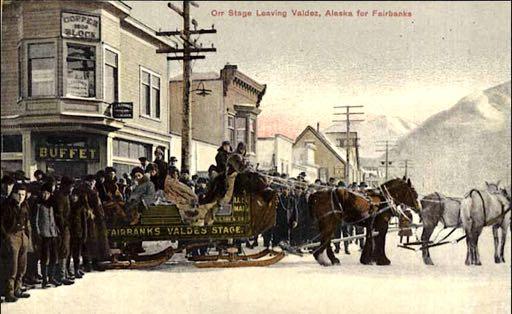
15 minute read
THE ORR STAGE COMPANY
Orr Stage on winter sled rails leaving for a trip from Valdez to Fairbanks. Signs in view, including “Copper Block and Dr. F. R. Chaney, Physician, suggest a date circa 1906. [Postcard from a photograph, published by Portland Post Card Co., Portland & Seattle]
The Edward S. Orr Stage Company
Advertisement
In 1910 a Mr. Hallock C. Bundy undertook the compiling and publication of a traveller’s guidebook to a large portion of Alaska. Grandiously titling his book The Valdez-Fairbanks trail : the story of a great highway : the Tanana Valley - Valdez, the gateway to an empire : a guide for the Alaska traveler, Mr. Bundy set about chronicling the routes to the territory’s towns and major settlements, and included chapters by several men of prominence, such as Governor Walter E. Clarke, Judge James Wickersham, Major Wilds P. Richardson, C. C. Georgeson, and John P. Clum. With splendid historic photographs and advertising from dozens of the era’s best-known businesses, the guidebook is a rich storehouse of Alaskan history.
Among the more interesting advertisements are those promoting the stage services provided by Edward S. Orr, proudly claiming “Eight day service between Valdez and Fairbanks, a distance of 364 miles,” and “All stages equipped with abundance of fur robes and carbon-heated foot warmers.”

Advertisement in Hallock C. Bundy’s 1910 guidebook, The Valdez-Fairbanks Trail.
[Available to read or download at the U. S. Library of Congress]
The teams were said to be changed every twenty miles, and there were “Frequent stops at comfortable roadhouses, and telegraph stations every forty miles.” Among the roadhouses the Orr Stage Company stopped at regularly, the Wortman Roadhouse, only 24 miles from Valdez, was a favorite, being “…one of the oldest established hotels on the trail. During the last two seasons it has been much enlarged and improved. There are excellent accommodations for 100 people. The sleeping apartments are exceptionally good and are furnished with spring beds. Baths can be had if wanted.”

Orr Stage Company wagon and team with “A stage load of travelers, Fairbanks-Valdez Trail.”
Handcolored postcard, photograph by Albert Johnson. [UAF-1989-166-1192-Postcard]
Also mentioned at Wortman’s Roadhouse are the “warm, roomy stables that can shelter 100 head of horses,” and farther along the trail, roadhouse after roadhouse includes references to their facilities for the Orr Stage Company stock.
“Beaver Dam is one of the Orr Stage stations and is well equipped for the accommodations of guests and their horses or dogs…”
Gulkana is “one of the Orr Stage stations and is known as one of the largest and best equipped….” At the Pile Driver or 30-mile roadhouse “the stables will house 48 head of stock and are heated.” Byler’s Roadhouse is the first Orr Stage station and a popular stopping place.” A singular publication of the day, the 1906-1907 Boston Alaska, gave a good description of the Orr Stage Company: “Fast sled services, with several relays of horses, has been established by Ed. S. Orr, formerly of Tacoma, with headquarters in both Valdez and Fairbanks. Mr. Orr personally is on some part of the trail most of the time, overseeing the work of his men and teams. Between Valdez and Fairbanks are thirty-five of what are known as roadhouses. At these the traveler may stop and refresh himself, the driver feed and water his horses, and all put up for the night when darkness overtakes. The fare at these places is not exactly sumptuous, but substantial, and the journey is made warm and comfortable. A good many women, wives and daughters of Fairbanks and Valdez men, make the trip both in an out over this winter trail without suffering any particular discomforts, and women in some instances have taken their babies in, always with safety. The trip is of necessity a dreary one, the snow-covered scenery is monotonous, and the travelers furnish their own good cheer. But as far as comfort is concerned, little is lacking that is absolutely necessary. The trip requires eight to ten days, an average of thirty-five to forty-five miles per day. This compares favorably with freight movement on some of the railroads outside. For the comfort of the women passengers a ‘carbonbrick’ burner is furnished for a foot warmer. It can be heated sufficiently at a roadhouse to retain its heat four or five hours.”

Orr Stage, signs on the sleigh read: "U.S. Mail", "Ed. S. Orr & Co.", and "Fairbanks Valdez Stage.”
Albert Johnson Photo [U. of Alaska Fairbanks, Albert Johnson Collection UAF-1989-166-105]
The Edward S. Orr Stage Company, also known as the Fairbanks-Valdez Stage Company, was only one of several stage lines which operated along the Valdez-to-Fairbanks and Chitina to Fairbanks Trails in the early years of the twentieth century, but it was uncontestably the most successful.
Edward S. Orr was born in Clarion County, Pennsylvania, between 1850 and 1854 (discrepancies exist), the son of pioneers who had been farming their land for over 100 years. He began contracting work in the oil fields of western Pennsylvania, but In 1877 he moved to Wichita, Kansas and began raising stock and farming. A year later his troublesome health forced him to relocate to Colorado, where he developed an interest in gold mining in the San Juan Mountains.

From Bundy’s 1910 trail guide.
In 1888 Ed Orr married Jennie McClure, who he had known in Pennsylvania, and they had a son, who they named Thorold Dewey Orr. They moved to Washington territory that year, becoming active in the early history of the city of Tacoma and forming a real estate business, Hill, Orr & Craig, in 1889. Orr was elected a member of the city council in Tacoma in 1889 and mayor of Tacoma in 1893, a capacity in which he served for two terms. He appointed a young James Wickersham to serve as his City Attorney.
When the Klondike gold rush started, Ed Orr was in the right place and quickly made his way north. The Dyea Trail newspaper announced on January 19, 1898, “Ex-Mayor Edward S. Orr of Tacoma is here. He did not come with the intention of locating, but he is inclining that way.” Orr did decide to stay, and formed a small freighting company with William V. Tukey, of Boise, Idaho. Their string of packhorses hauled goods for the Chilkoot Railroad & Transport Company from Dyea to Sheep Camp, where the cargo was transferred from horseback to buckets and sent to the summit via a cable tramway. In 1899, after completing their narrow-guage railroad over White Pass, the White Pass & Yukon Railroad bought out the Chilkoot Railroad & Transport Company, effectively ending Orr and Tukey’s freighting company.
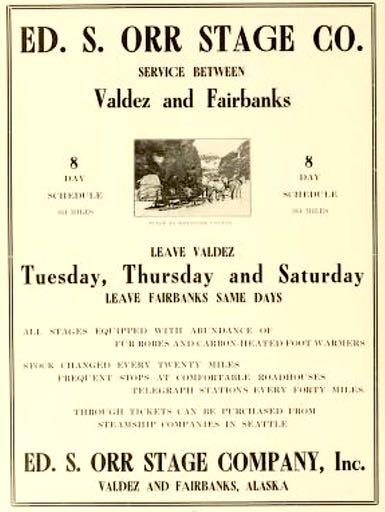
From Bundy’s 1910 trail guide.
In August, 1899, Orr and Tukey loaded 28 horses and 70 mules, along with a dozen people and several tons of goods, into nine scows and sailed them from Lake Bennett down the Yukon River to Dawson City, arriving to great fanfare on August 21st. Orr’s wife Jennie and their young son, Thorold, were among the passengers.
Orr and Tukey soon established a freighting company in their names, operating from an office at Second Avenue and Second Street in downtown Dawson City. In December, 1899, a fire destroyed the building and they moved to new quarters near the Dawson waterfront on the Yukon River. Business was brisk for Orr & Tukey, and they advertised that they would carry “All kinds of freight, to any of the creeks, safely and quickly delivered.” They carried mail, parcels, passengers, and both light and heavy freight, utilizing horses, mules, and dogs, pulling various types of wagons or sleds.
Orr’s old friend James Wickersham visited him in Dawson en route to his new appointment as territorial judge in Eagle, and in his book, Old Yukon: Tales, Trails and Trials (St. Paul: West Publishing Co., 1938), he described Orr as “six feet tall, handsome and generous.”
There were introductions to city officials, many of whom both had known in Washington, and tours of the gold mining operations on Bonanza and Eldorado Creeks. The city officials were surprised when Orr drove the stage to the diggings, and Wickersham noted that their excitement grew as they entered “the gateway to the gold gulches…” In 1901 Orr & Tukey merged their freighting business with the Hadley Stage Line. Their expanded freighting and stage business extended to a small mining camp on the Alaskan side of the border named Fairbanks, and when a gold strike was announced there in 1903 it did not go unnoticed by Ed Orr. But business was briskly moving along in the Yukon, and The Orr & Tukey Co., Ltd. was one of the largest freighting companies in the territory. But in 1905 Orr’s partner, William Tukey, retired to Idaho. The following year, 1906, Ed Orr moved his family and his freighting company to Valdez, Alaska.

Section of a 1914 Kroll Map of Alaska, showing the Valdez-to-Fairbanks Trail and roadhouses along the 364 mile route.
The Ed. S. Orr Stage Company offered both freight hauling and passenger service between Valdez and Fairbanks, with 50 drivers and 150 horses. There were two departures each week from Valdez, for a trip which could take nine days, depending on the condition of the trail. The company set a new record in its first season, however, making the trip in six days, 10 hours.
The Orr Stage Company was successful from the start, and Ed Orr bought out the rival Kennedy Stage Company, making his the largest such company in Alaska in 1909. The fare from Valdez to Fairbanks was $150, the return trip was $125, on sleighs which could carry ten passengers on four double seats. Horses were changed out every 20-25 miles, and a telegraph station could be found approximately every 40 miles for safety and convenience.
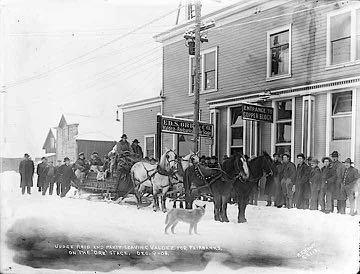
“Judge Reid and party leaving Valdez for Fairbanks on the 'Orr' Stage. Dec 9, 1908.”
Photographer: P. S. Hunt. [Mary Whalen Collection, Univ. of Alaska Fairbanks UAF-1975-84-281]
The winter of 1909-1910 was brutally cold, and one of Orr’s drivers wired the company agent in Fairbanks to warn against sending passengers over the trail until the weather moderated. The Fairbanks Daily News-Miner reinforced the warning with a bold headline across four columns of the front page: “More People Die on Valdez Trail.” An elderly woman from Chena, a community which was just downriver from Fairbanks, had died on one of Orr’s stages near Miller’s Roadhouse, apparently of a heart attack. The driver telegraphed the news to company officials, then secured her body at the roadhouse until arrangements could be made to return her to Fairbanks.
By the spring 1910 improvements to the trail were such that the Orr Stage Company added wheeled stages and continued trips to Fairbanks during the spring and summer, but also in 1910 Ed. S. Orr began considering a return to Washington state, as the myriad stresses of overseeing the company had resulted in his health once again declining. On August 27th the Fairbanks Daily News-Miner noted, “Owing to his ill health Ed. S. Orr, for some time past had been trying to shift the burden of the stage line over to other shoulders….” Jesse C. Martin, who had managed the company office in Valdez, was appointed General Manager of the stage line, and Ed. S. Orr and his family returned to Washington, where Orr underwent medical treatment and slowly regained his health.
J. C. Martin had traveled to Fairbanks shortly before Orr left the territory, and the two men discussed the future of the company and the nearing completion of the Copper River & Northwestern Railroad from Cordova to Chitina. Once the railway was completed there was a possibility of stage traffic from Valdez being diverted to the new route, as it would potentially cut a day and a half of travel from the current schedule. With his health unsteady, Orr decided to let someone else handle the inevitable changes ahead for the company, and by November he had sold the Orr Stage Company to the Northern Commercial Company.
As predicted, the well-situated town of Chitina, on the Copper River, grew quickly once the Copper River & Northwestern Railroad was completed in September, 1910. The railroad was constructed to haul copper ore from the mines at Kennecott to the port at Cordova, and Chitina became known as the town “where the rails meet the trails.” During the town’s boom years, 1910 to 1938, it was a busy center of commerce as trains, autos, stagecoaches, dogteams, and steamboats all passed through the town.

Orr Stage in Keystone Canyon, north of Valdez.
Photographer George C. Cantwell. [Alaska State Library. ASL-P44-03-172 Skinner Foundation, Alaska Steamship Company, 1890s-1940s. ASL-PCA-44]
In early October, 1910, Jesse Martin made a trip to the new townsite and purchased six building lots for the company, on which would be built stables, barns, a blacksmith shop and other structures necessary to Orr Stage Company business. By November a new cutoff was completed between Chitinia and the Valdez-Fairbanks Trail, and Jesse Martin and his wife moved into a temporary apartment in the Hotel Chitina while a new log cabin home was under construction nearby. When it was completed in December, 1910, the Chitina Leader described it as “one of the neatest and most substantial log cabin cottages in Alaska, which will, unless destroyed, stand as a landmark for many years to come.” The words of the Chitina Leader were prophetic, because the Orr Stage Company Superintendent’s Cabin became part of the Wrangell-St. Elias National Park and Preserve, and was restored in 1991-92 to be used as a ranger station and visitor’s center, a purpose which the historic log cabin still serves today. Visitors can view the original owner’s initials, “J.C.M.,” clearly scrawled on the wooden ceiling.
The first Orr Stage Company stagecoach left Chitina on November 25, carrying 27 sacks of mail, and the first southbound stage from Fairbanks set a new record for the trip. Leader reported on November 26th that the passengers who got off the stage to board the train for Cordova had “nothing but praise for the service they received along the way.”
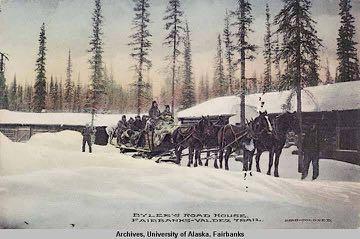
“Fairbanks-to-Valdez stage in front of Byler’s Road House.”
Photo by Albert Johnson. [Hand-colored postcard, University of Alaska Fairbanks UAF-1989-166-1214-Postcard]
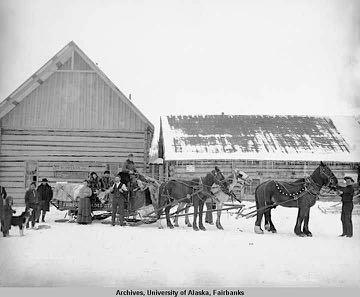
The Chitina-Fairbanks-Valdez stage in front of Tonsina Road House. Photo by Albert Johnson. Signs on the building behind the coach read: "80 miles to the bank and store of A.L. Levy & Co. Valdez" and "77 1/2 miles to Hotel Stelias, Valdez, Poot & Davis, Prop's, Fairbanks Headquarters.”
[Archives, Univ. of Alaska Fairbanks, Albert Johnson Collection, 1905-1917]
With continued improvements to the trail and a favorable snowfall to cushion the trip, operations ran smoothly that winter of 1910-1911. In March the train from Cordova was delayed by snow on the tracks, so Jesse Martin took the reins and drove the stage to set a new record for the trip to Fairbanks, arriving in only three days, 17 hours, and 30 minutes. The Chitina Leader sang the praises of the company in an editorial: “Little has been said so far of the Orr stage company, their competent officials and efficient drivers, but the Leader desires to go on record as saying that too much credit cannot be given the management of this stage company for the able manner in which the mail and passenger schedules have been handled this season. Considering the worst winter in years, the thirty-nine miles of new trail, and the unavoidable delays of the train which naturally upset their time and connections, they are to be equally commended, with the Katalla Company, in maintaining a service far better than the people of Alaska have enjoyed despite adverse conditions.”
In late August, 1911, a fire in Cordova claimed a large number of Orr Stage Company livestock and the company suffered a heavy loss of equipment. Jesse Martin resigned in September, to be replaced by Jack Rockafellow, the company’s bookkeeper. By the summer of 1911 the trail had been improved enough for wheeled vehicles to travel it during the summer, and the Chitina Leader ran an article in October, 1911 headlined “Automobile Road is Being Boosted.” Three years later, in September, 1914, Robert Sheldon drove the first car from Fairbanks to Chitina amidst much fanfare.
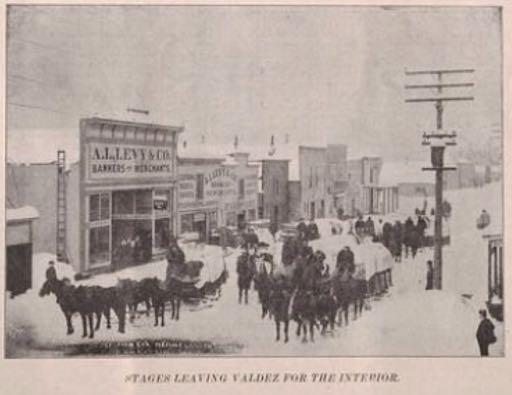
A photo which ran in a 1910 Fairbanks Daily News-Miner
The Orr Stage Company appeared to be in decline after 1912, as competing freighting companies arose that spring and summer. Advertising ceased after July, 1911, and in April, 1914 a tragic fire at the Orr Company barn at the Paxon Roadhouse claimed the life of Bobby Daw, the oldest of Orr’s stablemasters, and two horses. Ironically, ten days before the fire a meeting had been held in San Francisco at which the company directors gave their written consent to dissolve the company. The “Certificate of Dissolution of the Ed. S. Orr Stage Co.” is in the Nevada State Library archives in Carson City, Nevada, where Ed Orr had incorporated the company.
In June, 1914 Dan MacDonald, company superintendent for the line between Chitina and Fairbanks, drove the last stage to Fairbanks. The Fairbanks Daily News-Miner noted that the only serious accident during the year was the death of Bobby Daw in the Paxon fire, and commended the company for not misplacing a single piece of mail during the season.
In the 1991 National Park Service’s Historic Structures Report on the Superintendent’s cabin at Chitina, the legacy of the Ed. S. Orr Stage Company is made clear: “Although the Ed. S. Orr Stage Company only operated in Chitina for a short time, the company itself traces its roots deep into the development of the transportation industry in Alaska and the Yukon. Mr. Orr was one of the foremost pioneers in building not only a transportation empire, but through his efforts and good management of his company, he greatly impacted the development of the mining industry in and around Dawson City, Fairbanks, and finally along the Valdez-Fairbanks Trail.
“His fine sense of business and community loyalty allowed him to build an empire that started with a string of horses at Dyea in 1898 and ended with the largest freighting and passenger stage line in Alaska by 1910. It was only after he sold out to the Northern Commercial Company in the summer of 1910 that the company failed to thrive. It only took four years for the Ed. S. Orr Stage Company to become a memory, evident only in sources scattered throughout the western United States, Canada, and Alaska.”
There is a footnote to the story, found in an online search for photographs and information relating to the Ed. S. Orr Stage Company. A website for Washington Rural Heritage, a project of the Washington State Library, includes the Orcas Island Heritage Collection, which has a large collection of photographs by James T. Geoghegan (1869-1953), who went to Alaska in 1897 as a prospector in the Yukon gold rush.
Among the photos are many of the ChitinaFairbanks trail, and an entire page of photographs showing the summer pastures of the Orr Stage Company horses: “The U.S. Mail is handled by the Ed S. Orr Company in connection with their passenger and express line from Chitina to Fairbanks. Over 200 horses are used to keep the mail moving six times a week over the 310 miles of winter trail to Valdez. In summer the horses are pastured in two herds at Donnelly and Gulkana where the open river bottoms yield abundant pasture and freedom from mosquitoes. The wide Delta valley is carpeted with pea vine and grass, good pasture for the horses.” ~•~

1910 Fairbanks Daily News-Miner
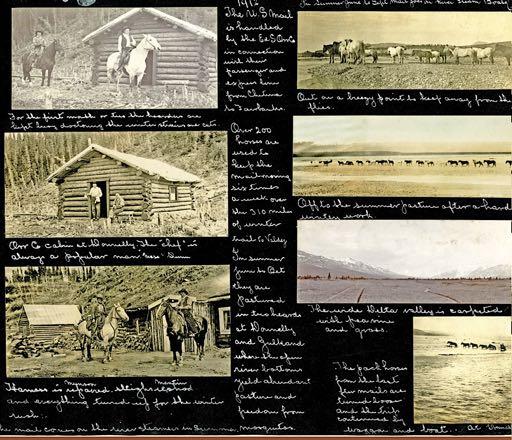
J. T. Geoghegan album page.






